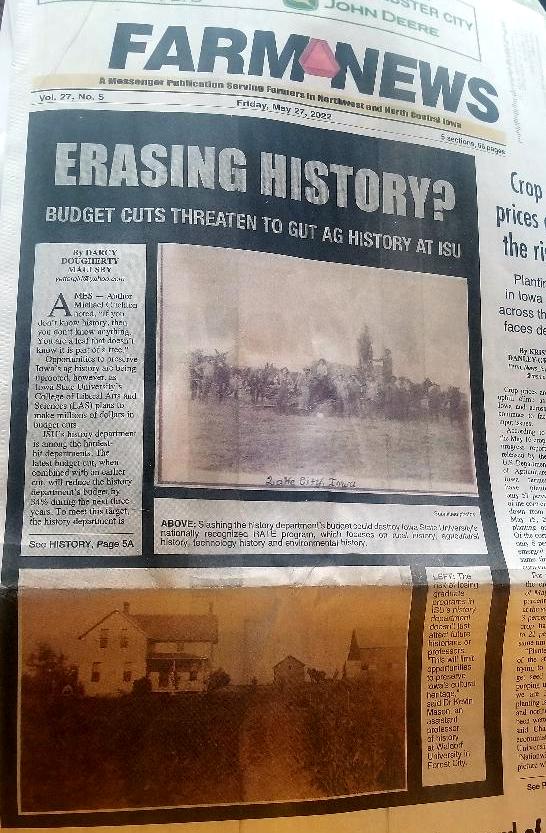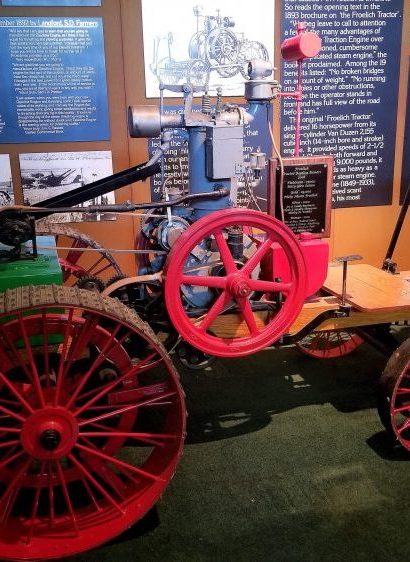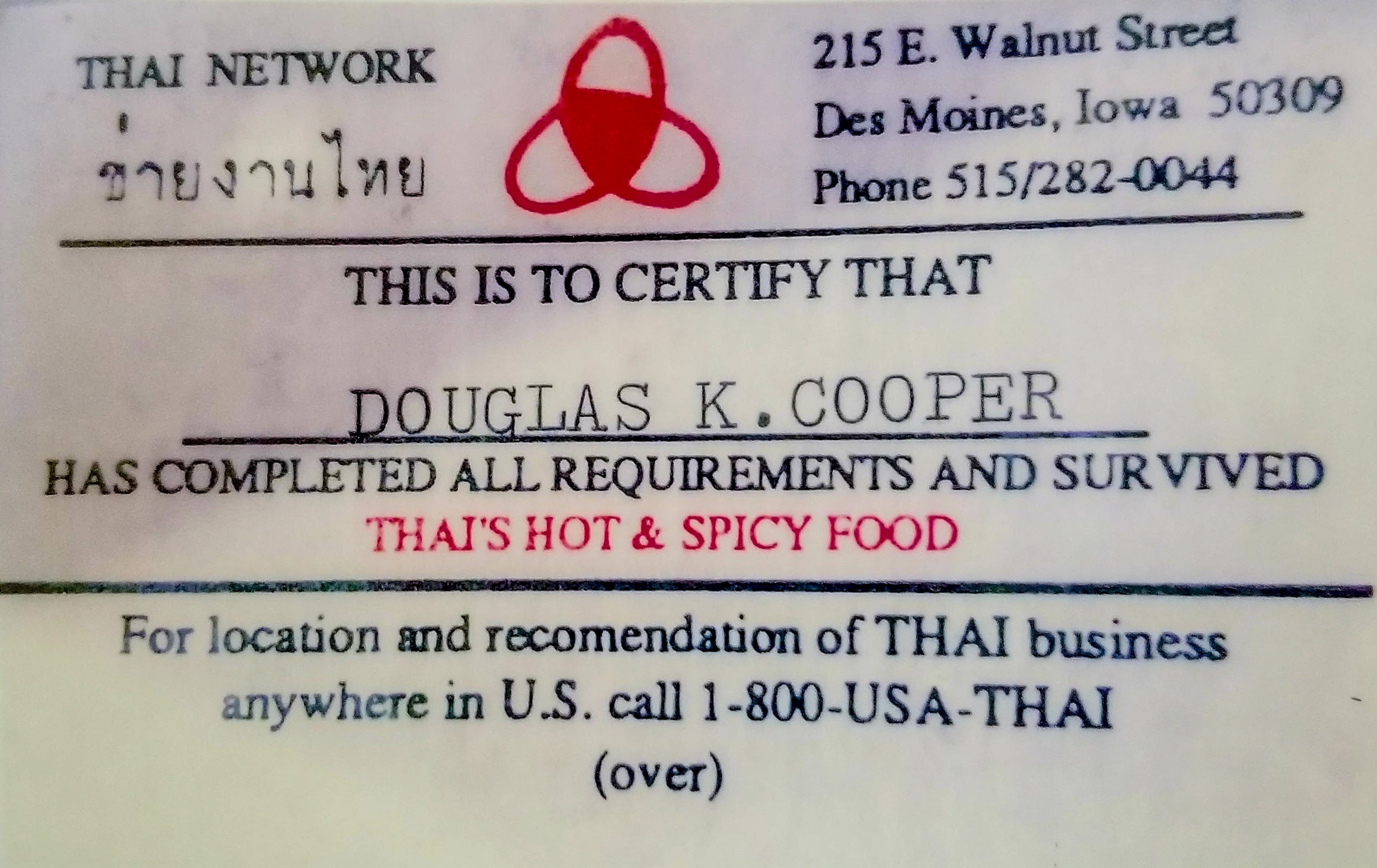
Whats HOT
Latest Posts
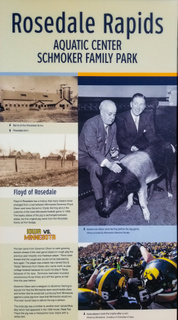
Iowa’s “Peacemaker Pig” Floyd of Rosedale Helped Calm Racial Tensions
If you follow college football in the Midwest, especially if you’re a University of Iowa Hawkeye football fan, you may know the story of Floyd of Rosedale. A bronze statue of the pig, Floyd of Rosedale, is exchanged between the two states. The original pig himself came from Rosedale Farms at Fort Dodge in north-central Iowa.
The whole deal emerged from a bet between Iowa Governor Clyde Herring and Minnesota Governor Floyd Olson about the outcome of the 1935 Iowa-Minnesota football game, but this story involves something much deeper than a famous pig and a bronze trophy.
The problem started the previous year, on Saturday, October 27, 1934, when rough play was directed towards one Iowa Hawkeye running back, Ozzie Simmons. Simmons was a rarity in that era: a black player on a major college football team. Dubbed the “ebony eel” by some sportswriters of the era, Simmons had come north to play football when he wasn’t allowed to play football in his home state of Texas, due to his race.
America in the 1930s included Jim Crow laws in southern states, which segregated blacks from whites. In northern states, no such laws existed, but discrimination was still widespread.
Simmons’ talent couldn’t be denied, however, and he attracted the attention of a young Iowa sports broadcaster perched high above the field. That broadcaster, who would become President Ronald Reagan, became an Ozzie Simmons fan, noted Minnesota Public Radio (MPR), which aired the story “The Origin of Floyd of Rosedale” in 2005. Reagan described a trademark Simmons’ move during a telephone interview with legendary Iowa sports broadcaster Jim Zabel of WHO Radio in Des Moines.
“Ozzie would come up to a man, and instead of a stiff-arm or sidestep or something, Ozzie — holding the football in one hand — would stick the football out,” Reagan said. “And the defensive man just instinctively would grab at the ball. Ozzie would pull it away from him and go around him.”
There were no dazzling runs against Minnesota, however, in the 1934 game at Iowa. Simmons was knocked out three times, leaving the game for good by halftime. The Gophers overwhelmed Simmons and the rest of the Iowa team, beating them 48-12.
While Minnesota went on to win the national championship that year, Iowa fans at the game were outraged by how Minnesota played, in Iowa City claiming the defense deliberately went after Iowa Simmons hard. (Just 11 years earlier, Iowa State’s first black athlete, Jack Trice, died of injuries sustained in a game at Minnesota in 1923.)
How Floyd of Rosedale was born
In 1935, the Rosedale Trophy debuted in an attempt to generate some goodwill between the two schools. Ahead of the 1935 game, Herring warned Minnesota not to pull the same stunts it did the year before. “If the officials stand for any rough tactics like Minnesota used last year, I’m sure the crowd won’t,” Herring said.
Olson sent a telegram to Governor Herring to assure him that the Minnesota team would tackle clean. To help calm the growing tension ahead of the next Minnesota-Iowa football game, Olson also went on to say that he would bet a prize pig from Minnesota against a prize pig from Iowa that Minnesota would win the big game. The loser would have to deliver the pig in person.
“Dear Clyde,” stated Olson’s telegram to Herring. “Minnesota folks are excited over your statement about the Iowa crowd lynching the Minnesota football team. If you seriously think Iowa has any chance to win, I will bet you a Minnesota prize hog against an Iowa prize hog that Minnesota wins today.”
The Iowa governor accepted, and what became known as the Floyd of Rosedale prize was born. Herring apparently followed Olson’s cue. He joked it would be hard to find a prize hog in Minnesota, since they all were so “scrawny.”
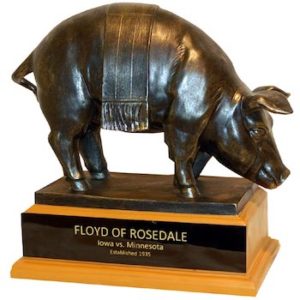
Floyd of Rosedale trophy
Word of the bet reached Iowa City as the crowd gathered at the stadium. Things calmed down, and the game proceeded without incident. Minnesota won 13-7.
The prize pig from Iowa was a Hampshire boar, black with a white belt. He was later named the Floyd of Rosedale after Minnesota’s governor. In the week following the big game, Herring delivered the live pig to the Minnesota Capitol building in St. Paul and took Floyd inside to meet Olson.
After the hog’s trophy days were over, Floyd spent his remaining days on a farm in southeast Minnesota. Floyd died of hog cholera in July 1936, about eight months after he made the front page. The real Floyd, Governor Olson, passed away less than a month later, dying of cancer in August 1936.
(Ironically, Floyd the hog wasn’t the only celebrity in his family. Floyd of Rosedale was the brother of another famous boar, Blue Boy, who had appeared in the 1933 movie “State Fair.”)
Leaving a legacy
All these years later, the famous Floyd of Rosedale endures as one of college football’s most famous trophies. Floyd of Rosedale’s legacy is also preserved in a marker by the Rosedale Rapids Aquatic Center in Fort Dodge.
Simmons, whose story prompted the Floyd of Rosedale trophy, never took much interest in the trophy, in part because of the era of racial discrimination it recalled. He was denied a chance to play professional football, because the National Football League banned black players at the time, noted MPR. He played some minor league ball, joined the Navy and eventually became a Chicago public school teacher.
“When Ozzie Simmons stepped onto the field in October, 1934, to play Minnesota, he entered a national drama that’s still playing out today,” MPR noted. “All Simmons wanted was a chance. The trophy is an ever-present reminder of how precious that right is.”
Want more stories like this?
These are the kinds of stories I’m sharing in my new book, “Iowa Agriculture: A History of Farming, Family and Food,” which was released by The History Press on Monday, April 27, 2020. Order your signed copy by clicking here to my online store.
One more thing–the story of illegal gambling
After I posted this story, I received this intriguing email from my friend Victoria Herring of Des Moines:
“You may remember coming to Artisan Gallery 218 to do book talks. I was reading your website about the Floyd of Rosedale story – apparently appearing in an upcoming book. I assume you know there’s a bit more to the story == I think George Mills wrote about it in one of his books == when this happened some guy [whose name I forget but he was a bit of a thorn in the side of some public figures] filed a criminal complaint against Gov. Herring [he was my grandfather] alleging illegal betting — might be an interesting even if a little off topic addition.”
I pulled out a copy of George Mills’ classic book, Looking in Windows: Surprising Stories of Old Des Moines, and saw exactly what Victoria was talking about. In the second called “A Governor Arrested,” Mills explained how a gadfly named Virgil Case in Des Moines got a warrant for Governor Herring’s arrest following the Floyd of Rosedale 1935 bet. The charge? Gambling on a hog wager.
At the time, Iowa law provided a penalty of up to a $100 fine or 30 days in jail for gambling. Municipal Judge J.E. Mershon signed the warrant.
Who was Case and why did he go to all this trouble? He was a “natural-born hell raiser,” wrote Mils, who added that Case had been a secretary to a Des Moines mayor and publisher of a weekly newspaper.
Case explained how he happened to file the charge. He said he had some spare time, and it occurred to him a “good way to put in that time was to go over to Municipal Court and have the governor arrested. So that’s what I did.” He said his profession was “raising hell with public officials because they should be the first to set a good example.”
Word of the warrant reached Herring while he was still with Minnesota Governor Olson in Minneapolis. Herring immediately engaged Olson as his attorney. Olson squelched a suggestion that the pig be auctioned off to pay a possible Herring fine. “That pig stays in Minnesota, regardless of what happens,” Olson declared. He added that the bet wasn’t a gamble anyway, since Minnesota was a cinch to win the game.
Olson suggested that Herring stay in St. Paul, where he couldn’t be extradited, since the Minnesota governor had to consent to the extradition, and Olson was already Herring’s attorney. Herring observed that only the governor of Iowa could extradite anyone back to Iowa–and he was the governor of Iowa.
“Olson added a sly insult when he said it wasn’t gambling because ‘nothing of value was involved,'” Mills wrote. Herring shot back that Floyd of Rosedale was a “right good hog.”
Walter Brick, deputy municipal court bailiff, cause a stir of excitement at the Iowa statehouse a few days later. When he showed up at Herring’s office, reporters thought maybe he was there to lead the governor away in handcuffs. Nope. Brick just wanted to talk over a planned court hearing on the charge.
The only action the deputy took that day was to join the reporters in eating apples out of Herring’s fruit basket. (“Beside apples, Herring was known at times to shut the door and provide the press with beer and Pella bologna, something no governor has done since,” Mills wrote.)
In the hearing, reporters and others testified that Herring hadn’t committed the so-called offense in Des Moines, that the bet wasn’t complete until Herring and Olson met in Iowa City. Assistant Polk County Attorney C. Edwin Moore, later chief justice of the Iowa Supreme Court, moved that the case be dismissed. Judge Mershon was glad to do so. “The folderol was over,” Mills concluded.
Want more?
Thanks for stopping by. I invite you to read more of my blog posts if you value intriguing Iowa stories and history, along with Iowa food, agriculture updates, recipes and tips to make you a better
If you’re hungry for more stories of Iowa history, check out my top-selling “Culinary History of Iowa: Sweet Corn, Pork Tenderloins, Maid-Rites and More” book from The History Press. Also take a look at my latest book, “Dallas County,” and my “Calhoun County” book from Arcadia Publishing. Both are filled with vintage photos and compelling stories that showcase he history of small-town and rural Iowa. Order your signed copies today! Iowa postcards are available in my online store, too.
If you like what you see and want to be notified when I post new stories, be sure to click on the “subscribe to blog updates/newsletter” button at the top of this page, or click here. Feel free to share this with friends and colleagues who might be interested, too.
Also, if you or someone you know could use my writing services (I’m not only Iowa’s storyteller, but a professionally-trained journalist with 20 years of experience), let’s talk. I work with businesses and organizations within Iowa and across the country to unleash the power of great storytelling to define their brand and connect with their audience through clear, compelling blog posts, articles, news releases, feature stories, newsletter articles, social media, video scripts, and photography. Learn more at www.darcymaulsby.com, or e-mail me at yettergirl@yahoo.com.
Let’s stay in touch. I’m at darcy@darcymaulsby.com, and yettergirl@yahoo.com.
Talk to you soon!
Darcy

Are You on Team Cinnamon Roll?
It’s every marketer’s dream–a topic so compelling that no one can ignore it, and everyone wants to talk about it. Here in Iowa, this kind of topic revolves around that school-lunch classic–chili and cinnamon rolls.
Yep, it’s a thing, and it’s a beloved tradition here in my hometown of Lake City. I’ll never forget the comforting aroma of homemade rolls (caramel rolls, most of the time) filling the school, including our 1920s-vintage three-story high school. As if it weren’t hard enough to concentrate in math class, I had that enticing aroma to distract me–but oh what sweet torture!
I’m reliably informed that chili and cinnamon rolls are still a favorite school lunch in the local school district, as well as other schools around the state.
So when it was time to write the manuscript for my second book, “A Culinary History of Iowa,” I started talking to sources about the history of chili and cinnamon rolls. Not only did I discover that no one seems to remember the origins of this phenomenal combo, but it’s not something that every Iowa school kid grew up with.
Some people had never heard of it. Others said their school served peanut butter sandwiches with chili. There were those who couldn’t imagine chili without cornbread. Still others, including a friend from Minnesota, were revolted. “That makes no sense! That’s like eating scrambled eggs and birthday cake together!” said one Minnesota native.
Whether you love it or hate it, seems like everyone has an opinion about chili and cinnamon rolls. Click here for a snippet from my Culinary History of Iowa book to help whet your appetite about the history of chili and cinnamon rolls–along with an amazing recipe!
This food combo is also a surprisingly newsworthy topic. A reporter from the Des Moines Register interviewed me for the recent article “The history behind Iowa’s unique taste for chili and cinnamon rolls.”
The day after that story ran, I received an email from Jodi Long, a reporter for TV-13, the NBC affiliate in Des Moines. She wanted to do a segment on the history of chili and cinnamon rolls, so we filmed the segment last Friday. As soon as it aired on the early morning news segment this past Monday, I started getting comments, kudos and questions on Facebook and beyond.
(I love the Team Cinnamon Roll and Team Cornbread idea that Jodi included in her Facebook post. To watch the news segment, click here!)
I learned three things from this experience:
1. Realize that things you take for granted might be quite newsworthy, and look for ways to showcase these stories. (Your website, newsletter, e-newsletter, social media posts, press releases, videos, podcast or other communication tools might be just the place to share these stories.)
2. Respond quickly when the media wants to interview you about a topic. Reporters need to know sooner rather than later whether you can help them. Don’t miss the opportunity for free publicity.
3. Invite people to join the conversation. So I want to know–are you on Team Cinnamon Roll or Team Cornbread?
Want more?
Thanks for stopping by. I invite you to read more of my blog posts if you value intriguing Iowa stories and history, along with Iowa food, agriculture updates, recipes and tips to make you a better communicator.
If you like what you see and want to be notified when I post new stories, be sure to click on the “subscribe to blog updates/newsletter” button at the top of this page, or click here. Feel free to share this with friends and colleagues who might be interested, too.
Also, if you or someone you know could use my writing services (I’m not only Iowa’s storyteller, but a professionally-trained journalist with 20 years of experience), let’s talk. I work with businesses and organizations within Iowa and across the country to unleash the power of great storytelling to define their brand and connect with their audience through clear, compelling blog posts, articles, news releases, feature stories, newsletter articles, social media, video scripts, and photography. Learn more at www.darcymaulsby.com, or e-mail me at yettergirl@yahoo.com.
If you’re hungry for more stories of Iowa history, check out my top-selling “Culinary History of Iowa: Sweet Corn, Pork Tenderloins, Maid-Rites and More” book from The History Press. Also take a look at my latest book, “Dallas County,” and my Calhoun County” book from Arcadia Publishing. Both are filled with vintage photos and compelling stories that showcase he history of small-town and rural Iowa. Order your signed copies today! Iowa postcards are available in my online store, too.
Let’s stay in touch. I’m at darcy@darcymaulsby.com, and yettergirl@yahoo.com.
Talk to you soon!
Darcy
@Copyright 2019 Darcy Maulsby & Co. Blog posts may only be reprinted with permission from Darcy Maulsby.

A Dirty Tip to Make Your Social Media Content More Shareable
Tire turd (noun): Wad of snow, ice, salt and gravel that piles up behind each vehicle tire in the winter. Removable only with explosives. #Iowa #winteriniowa
That’s a recent Facebook post I created when was in Red Oak, Iowa, this week, working on a newsletter for United Farmers Cooperative. When I stopped at the grain elevator, I saw this tire turd on my car. I decided to share it on my personal Facebook page. This silly post apparently struck a chord, because it has been liked 159 times, generated 23 comments and has been shared 17 times. Crazy!
This reminds me of one of the principles I teach in my storytelling classes. Shareability is a key to the most successful social posts.
People don’t just share any old content. Facebook reports that 0.5% of those who see a Facebook post share it. Of all the content links the average Twitter user receives, the re-tweet ratio is 1:318, according to one of my favorite books, “The Content Code,” by Mark Schaeffer.
Research sponsored by the New York Times found that people share content to:
• To be useful, since the info. is practical or timely
• To define themselves to others (look smarter, funnier, more relevant)
• To strengthen relationships with others
• Get the word out about causes, brands, events, etc. they care about
Think about the last time you shared something. What motivated you to do this?
How could you frame your stories and information to make your content more shareable?
Want more?
Thanks for stopping by. I invite you to read more of my blog posts if you value intriguing Iowa stories and history, along with Iowa food, agriculture updates, recipes and tips to make you a better communicator.
If you like what you see and want to be notified when I post new stories, be sure to click on the “subscribe to blog updates/newsletter” button at the top of this page, or click here. Feel free to share this with friends and colleagues who might be interested, too.
Also, if you or someone you know could use my writing services (I’m not only Iowa’s storyteller, but a professionally-trained journalist with 20 years of experience), let’s talk. I work with businesses and organizations within Iowa and across the country to unleash the power of great storytelling to define their brand and connect with their audience through clear, compelling blog posts, articles, news releases, feature stories, newsletter articles, social media, video scripts, and photography. Learn more at www.darcymaulsby.com, or e-mail me at yettergirl@yahoo.com.
If you’re hungry for more stories of Iowa history, check out my top-selling “Culinary History of Iowa: Sweet Corn, Pork Tenderloins, Maid-Rites and More” book from The History Press. Also take a look at my latest book, “Dallas County,” and my Calhoun County” book from Arcadia Publishing. Both are filled with vintage photos and compelling stories that showcase he history of small-town and rural Iowa. Order your signed copies today! Iowa postcards are available in my online store, too.
Let’s stay in touch. I’m at darcy@darcymaulsby.com, and yettergirl@yahoo.com.
Talk to you soon!
Darcy
@Copyright 2019 Darcy Maulsby & Co. Blog posts may only be reprinted with permission from Darcy Maulsby.

Tex-Mex Sloppy Joes and the Magic of Maid-Rite in Iowa
From time to time I get calls from around Iowa or across the country, usually from the media, about the history of Iowa food. Even the Travel Channel reached out for an upcoming Iowa episode of Bizarre Foods: Delicious Destinations. (Don’t miss this cool story!) People usually want to talk about one thing—Maid-Rites. I love sharing this story and have also cooked up my own twist on loose-meat sandwiches.
Just the other day a friend emailed me about Maid-Rites, wanting to know some other names for the sandwich. Here’s what I told her:
* Loose-meat sandwiches
* Taverns (a common term around Sioux City and parts of northwest Iowa)
* Beef burgers
* Canteens (in Ottumwa)
* Sloppy Joes (if they contain ketchup and other goodies in the mix)
* Yip-yips (at least in southern Illinois, or so I’ve been told!)
While you can sometimes find these sandwiches on some café menus in Iowa, as well as at the 30+ Maid-Rite chain restaurants around the Midwest, they are often turn up at potlucks, fundraiser meals, family get-togethers, civic group lunches and more.
Just when I think I’ve seen every type of these loose-meat sandwiches, there’s another version that pops up. When I shared my “How to Take Better Photos in 1 Minute” class with the Rockwell City Rotary Club recently, the meal included Tex-Mex inspired sloppy joes. While I don’t normally care for sloppy joes, I absolutely loved these sandwiches.
I loved them so much I was inspired to create my own version. These are flavorful, stick-to-your-ribs sandwiches that come together in a snap and can be as spicy or as mild as you like. They’re also an ultimate comfort food on these cold winter days here in Iowa.
Here’s the recipe. Enjoy! Also, keep reading below for the fascinating history of Maid-Rite in Iowa. This is an excerpt from my 2016 book, “Iowa’s Culinary History: Sweet Corn, Pork Tenderloins, Maid-Rites & More.” Order here to get your own signed copy of this fun book!
Tex-Mex Sloppy Joes
• 1 pound ground beef
• 1 small onion, chopped
• 2 garlic cloves, minced
• 1 cup ketchup
• 1 can (4 ounces) chopped green chilies
• 1/2 cup beef broth
• 1/4 cup chili sauce
• 1/2 to 1 teaspoon chili powder, to taste
• 1/2 teaspoon ground cumin
• 1/4 teaspoon crushed red pepper flakes, optional
• 1/4 teaspoon salt
• 1/4 teaspoon coarsely ground pepper
• 6 hamburger buns, split
• 2 tablespoons butter, softened
In a large skillet, cook beef and onion over medium heat for 6-8 minutes or until beef is no longer pink, breaking up beef into crumbles; drain. Add garlic; cook 1-2 minutes longer. Stir in the ketchup, chilies, broth, chili sauce and seasonings. Bring to a boil. Reduce heat; simmer, uncovered, for 15 minutes, stirring occasionally.
Meanwhile, spread cut sides of buns with butter. Place on baking sheets, buttered side up. Broil 4 in. from the heat for 1-2 minutes or until toasted. Serve beef mixture in buns.
Now for a tasty bite of Iowa history
Call it the king of the loose-meat sandwiches. A tried-and-true Iowa classic for nearly 100 years, the Maid-Rite is a sandwich unlike any other. But first, let’s clarify what a Maid-Rite is not.
It’s not a sloppy joe. It’s not a ground-beef concoction with ketchup, mustard and sugar in the mix. (Some of these “hybrid” sandwiches with traits of both a Maid-Rite and a sloppy joe can be found in Iowa, and some are quite tasty, but a true Maid-Rite they are not.) Finally, a Maid-Rite is not something you can leave out if you’re going to delve into the culinary history of Iowa.
The story of the Maid-Rite began in 1926, when Fred Angell, a meat cutter in Muscatine, developed a recipe with just the right combination of ground beef (with a specific grind size and meat/fat ratio) and a distinctive seasoning featuring Fred’s unique blend of spices. When a deliveryman tasted Fred’s new creation, he exclaimed, “This sandwich is made right!”
With that, the Maid-Rite legend was born. “The Maid-Rite recipe has stayed the same from the beginning,” said Bradley Burt, president and CEO of the Maid-Rite Corporation based in West Des Moines. “There’s no other sandwich like ours.”
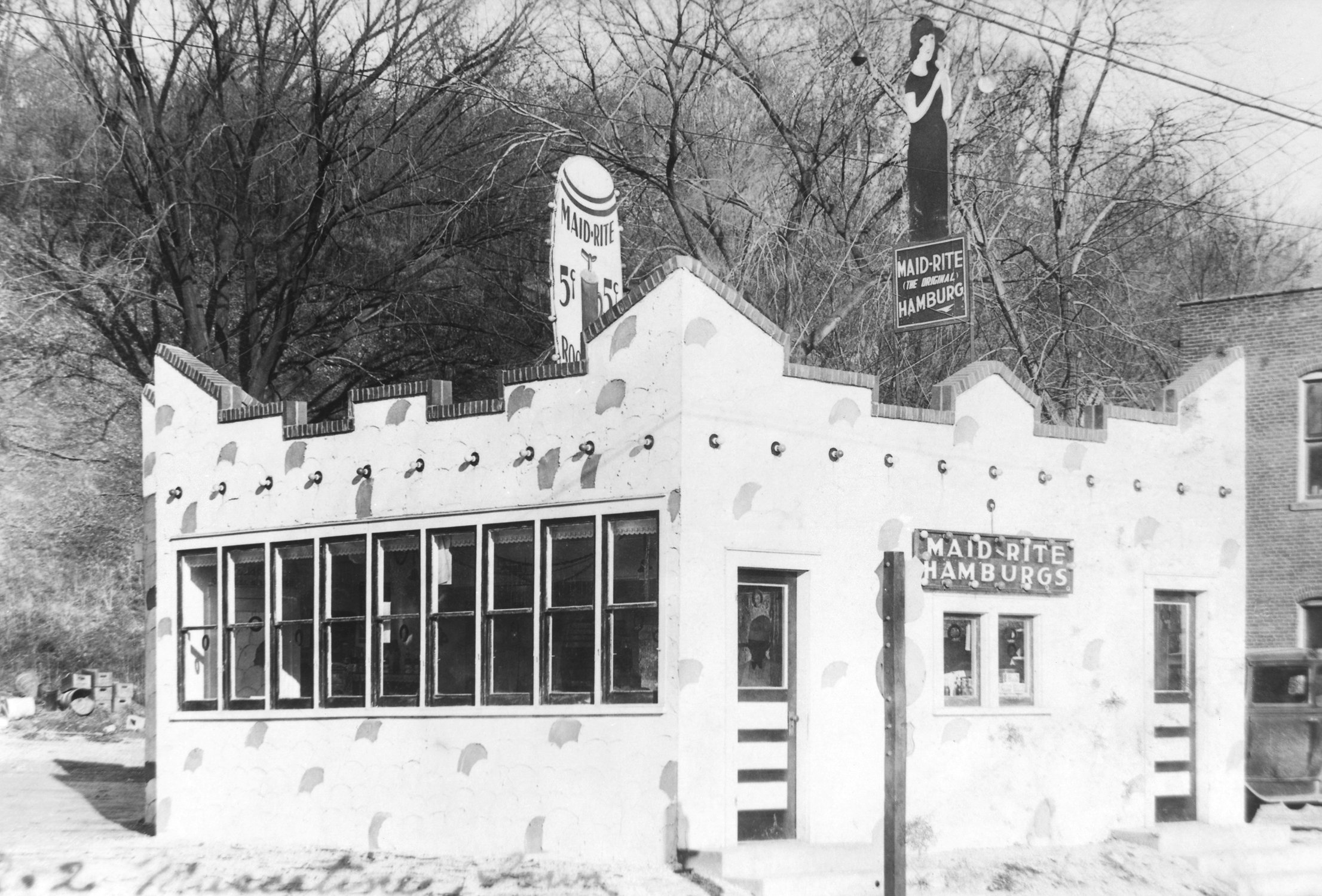
Early Maid-Rite sandwich shop. Photo courtesy of Maid-Rite Corp.
What started as a small Maid-Rite restaurant in Muscatine grew into one of America’s first quick-service, casual-dining franchise restaurants. Today there, are restaurants in eight Midwestern states, including 38 stores in Iowa. While the days of 5-cent Maid-Rites and homemade root beer are gone, Maid-Rite continues to pride itself on home-town hospitality. “Maid-Rite restaurants are still a gathering place in many small towns,” Burt said.
Some of these restaurants are as rich in history as the Maid-Rite sandwich itself. Taylor’s Maid-Rite in Marshalltown is a third-generation business that has been serving central Iowa for more than 80 years. Cliff Taylor purchased the 1928 franchise for $300. Cliff and his family operated Taylor’s Maid-Rite Hamburger Shop, baking pies at home, slicing whole pickles from Marshall Vinegar Works and buns from Strand’s Bakery.
After Cliff passed away in 1944, his son, Don, continued to run the restaurant. Don built a cooler in the basement of his home to store the hamburger that was ground daily. In 1958, he built a state-of-the-art Maid-Rite restaurant across the street from the original location, outfitting the new store with all stainless-steel equipment and two cash registers.
While various generations of the family have operated the business since then, many things haven’t changed. Like all Maid-Rite restaurants, each Maid-Rite at Taylor’s is made from 100% USDA Midwestern fresh ground beef served on a bun, with your choice of ketchup, mustard, onion and pickles. “We have stringent specifications for our beef,” Burt said.
Once you’ve tasted a real Maid-Rite, there’s no substitute. Many former Iowans don’t consider themselves to be officially back home in Iowa until they’ve eaten a Maid-Rite. “It’s quite a phenomenon,” Burt wait. Some Iowans can’t wait to get a taste of home. A group of snowbirds who spend their winters in Arizona host a Maid-Rite party in the Phoenix area each year for 150 guests, complete with Maid-Rite hats, t-shirts and aprons.
One of the biggest Maid-Rite fans of all would have to be Jim Zabel, who broadcast University of Iowa athletic events for 50 years. Before his passing in 2013, the legendary sportscaster and ultimate Iowa ambassador served as the Maid-Rite spokesman. He even made a commercial for Maid-Rite, complete with a riff on his high-energy slogan, “I love ‘em, I love ‘em, I love ‘em!”
Many Iowans stay loyal to their beloved Maid-Rites right to the end. Some people request them as their final meal, while others ask that Maid-Rites be served at their funeral dinner. “Maid-Rite is truly part of Iowa’s culture,” Burt said.
Want more?
Thanks for stopping by. I invite you to read more of my blog posts if you value intriguing Iowa stories and history, along with Iowa food, agriculture updates, recipes and tips to make you a better communicator.
If you like what you see and want to be notified when I post new stories, be sure to click on the “subscribe to blog updates/newsletter” button at the top of this page, or click here. Feel free to share this with friends and colleagues who might be interested, too.
Also, if you or someone you know could use my writing services (I’m not only Iowa’s storyteller, but a professionally-trained journalist with 20 years of experience), let’s talk. I work with businesses and organizations within Iowa and across the country to unleash the power of great storytelling to define their brand and connect with their audience through clear, compelling blog posts, articles, news releases, feature stories, newsletter articles, social media, video scripts, and photography. Learn more at www.darcymaulsby.com, or e-mail me at yettergirl@yahoo.com.
If you’re hungry for more stories of Iowa history, check out my top-selling “Culinary History of Iowa: Sweet Corn, Pork Tenderloins, Maid-Rites and More” book from The History Press. Also take a look at my latest book, “Dallas County,” and my Calhoun County” book from Arcadia Publishing. Both are filled with vintage photos and compelling stories that showcase he history of small-town and rural Iowa. Order your signed copies today! Iowa postcards are available in my online store, too.
Let’s stay in touch. I’m at darcy@darcymaulsby.com, and yettergirl@yahoo.com.
Talk to you soon!
Darcy
@Copyright 2019 Darcy Maulsby & Co. Blog posts may only be reprinted with permission from Darcy Maulsby.
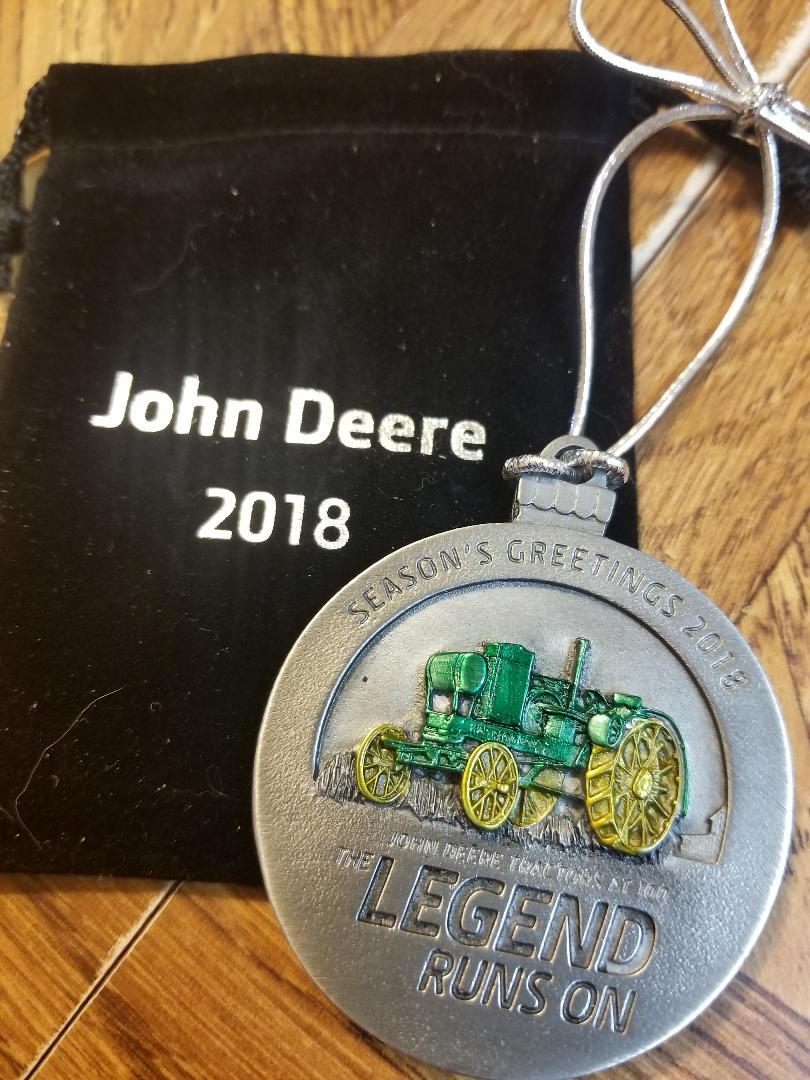
Butter Sculptures to Christmas Ornaments: Waterloo Boy Tractor Celebrates 100 Years
It’s hard to imagine a time when John Deere wasn’t a powerhouse in the tractor business. Yet, John Deere wouldn’t enter the farm tractor business until March 1918 through the acquisition of the Waterloo Gasoline Engine Company, and it’s a milestone that has been commemorated in everything from butter to Christmas ornaments.
Deere has featured a picture and story depicting the 100th anniversary of the iconic Waterloo Boy on its 2018 Christmas ornament. The 2018 Iowa State Fair also honored the tractor by featuring the world-famous Butter Cow beside a butter sculpture of the Waterloo Boy. Both butter masterpieces were displayed in the 114-year old John Deere Agriculture Building’s 40-degree cooler throughout the fair, which ran from August 9-19.
The Iowa State Fair has long been a prime venue to display Deere equipment in its various forms. A quote from the John Deere Sales Department in 1940 read, “I feel that the machinery and industrial exhibits for 1940 excelled any previous year’s display,” according to history shared by the Iowa State Fair. “We consider our Iowa State Fair exhibit to be a very beneficial part of our advertising program, and we will be with you again in 1941.’”
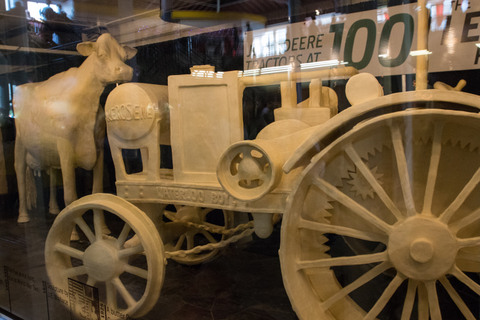
Waterloo Boy butter sculpture 2018 Iowa State Fair
Meeting the challenge of a reliable, durable tractor
Frequently ranked as one of the top events in the country, the Iowa State Fair is the single largest event in the state of Iowa and one of the oldest and largest agricultural expositions in the country and annually attracts more than a million people from all over the world.
In 2018, the Iowa State Fair used more than 50 John Deere tractors and utility vehicles provided by Van Wall Equipment. In addition, a 1919 Waterloo Boy model N tractor was on display in the Machinery Grounds at the Iowa State Fair.
To understand the significance of the Waterloo Boy, take a trip back in time, said Neil Dahlstrom, manager of the John Deere Archives and History. In the critical five-year stretch (1912-1917) prior to John Deere entering the tractor business, there were two key issues the company needed answered.
“First, what did farmers really want from a machine that would soon make the horse obsolete?” said Dahlstrom, who noted that salesmen, territory and branch managers, and Deere’s top leadership scoured the country to understand what customers desired.
Also, how could the equipment to be manufactured to be durable enough to stand up to daily farm use?
Deere had considered every imaginable idea. The company had developed one-, two- and four-cylinder concept tractors. Some ran on gasoline. Others ran on kerosene. Some had all-wheel drive. Others had front-wheel drive. The company even explored concepts like line steering, which was meant to replicate horse reins as the steering mechanism to ease farmers into power farming, Dahlstrom said.
A motorized cultivator, what Deere called a “Tractivator,” was brought to market by several competitors, but Deere determined it did not provide any cost savings compared to horses.
The challenge of producing a durable tractor loomed large. In a letter to company president William Butterworth in 1915, Deere’s superintendent of factories George Mixter noted that tractors offered by competitors up to that point “have not been built with the proper spirit behind the design and manufacture to insure their durability in the hands of the farmers.” But if Deere could “build a small tractor that will really stand up for five or more years’ work on the farm, I believe they will be a permanent requirement of the American farmer,” Mixter wrote.
Deere ultimately found the solution with the Waterloo Boy tractor and acquired the Waterloo Gasoline Engine Company in Waterloo, Iowa, on March 14, 1918. Although anxious to start selling the Waterloo Boy, Deere dealers had to wait while Deere honored existing contracts, which did not expire until Dec. 31, 1918, Dahlstrom said.
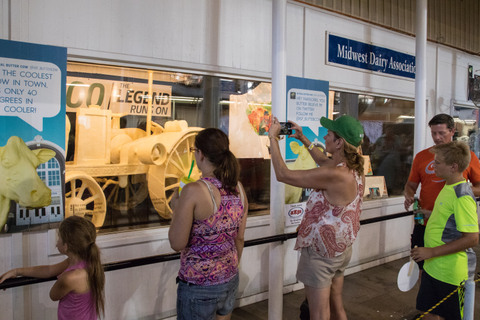
Visitors snapped photos of the iconic Waterloo Boy butter sculpture 2018 Iowa State Fair.
Waterloo Boy makes its debut
Deere put its money where its instincts were. Over the next year, the company spent more than one-third of its advertising budget touting the Waterloo Boy tractor, Dahlstrom said.
Specifically, Deere invested $50,000 on tractor advertising in the year following its debut of the Waterloo Boy—approximately $747,000 in today’s money. Another way to get the company’s new product out in front of customers was to take it on the road – literally.
The National Tractor Demonstrations started to become more mainstream after being introduced in the United States in 1913. An eight-city, eight-week tour schedule was the perfect opportunity to unveil Deere’s Waterloo Boy, Dahlstrom said. Salina, Kansas, served as the ideal backdrop in August 1918, since this was the nation’s largest demonstration.
Deere had participated in tractor demonstrations since the original Winnipeg Agricultural Motor Competitions in Manitoba, Canada, in 1908 – but not with a tractor. Instead, Deere had paired its plows with leading tractor manufacturers. That changed now that the Waterloo Boy was part of the Deere family.
At Salina, Deere spared no expense, showcasing 12 Waterloo Boy tractors as the centerpiece of a display that included John Deere signs, Waterloo Boy signs and a copper leaping deer statue, Dahlstrom said. “There were two stars during this week of 100-degree days – ‘ice water on tap’ and the Waterloo Boy Model ‘N’ tractor,” he added.
The Model “N” demonstrated its merits by pulling tractor plows, disc harrows and grain drills. Visitors were shuttled in three John Deere farm wagons pulled by Waterloo Boy tractors. By all accounts, the debut was a success.
“The award for the most elaborate, largest and most artistic exhibit tent at the Salina tractor show will undoubtedly go to the John Deere Plow company of Kansas City,” wrote the editors of a Kansas City newspaper.
As Deere’s advertising campaign swung into full gear, the Waterloo Boy tractor was promoted as the “best and most efficient tractor” on the market for farmers inclined to buy a tractor. By October 1918, readers of Deere’s magazine, The Furrow, saw an advertisement for the line of Waterloo Boy tractors and stationary engines. The ad guaranteed the Waterloo Boy’s “ample power for field and belt work.”
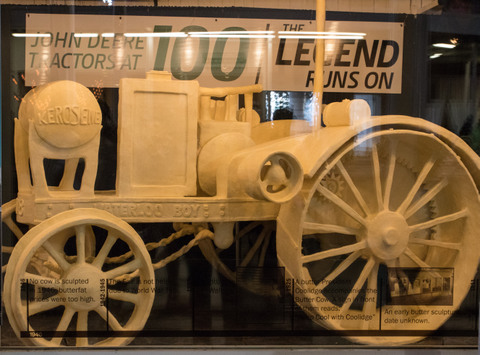
Waterloo Boy butter sculpture 2018 Iowa State Fair
In January 1919, with tractors now available through John Deere dealers, Deere’s first print ad for the trade press appeared in The Farm Implement News. It featured two areas of emphasis: “A Good Tractor Backed by a Permanent Organization.”
After years of development, John Deere customers and John Deere dealers finally had their John Deere tractor.
“It took longer than the company expected, but a determination to do it right instead of doing it fast now brought the John Deere tractor to market,” Dahlstrom said.
As a result, customers got “the assurance of more tractor work per dollar of fuel cost; longer tractor life with less repair cost; accessibility of parts that makes caring for the tractor simple and easy; and dependable power for all farm work.”
The tractor era had officially arrived.
Want more?
Thanks for stopping by. I invite you to read more of my blog posts if you value intriguing Iowa stories and history, along with Iowa food, agriculture updates, recipes and tips to make you a better communicator.
If you like what you see and want to be notified when I post new stories, be sure to click on the “subscribe to blog updates/newsletter” button at the top of this page, or click here. Feel free to share this with friends and colleagues who might be interested, too.
Also, if you or someone you know could use my writing services (I’m not only Iowa’s storyteller, but a professionally-trained journalist with 20 years of experience), let’s talk. I work with businesses and organizations within Iowa and across the country to unleash the power of great storytelling to define their brand and connect with their audience through clear, compelling blog posts, articles, news releases, feature stories, newsletter articles, social media, video scripts, and photography. Learn more at www.darcymaulsby.com, or e-mail me at yettergirl@yahoo.com.
If you’re hungry for more stories of Iowa history, check out my top-selling “Culinary History of Iowa: Sweet Corn, Pork Tenderloins, Maid-Rites and More” book from The History Press. Also take a look at my latest book, “Dallas County,” and my Calhoun County” book from Arcadia Publishing. Both are filled with vintage photos and compelling stories that showcase he history of small-town and rural Iowa. Order your signed copies today! Iowa postcards are available in my online store, too.
Let’s stay in touch. I’m at darcy@darcymaulsby.com, and yettergirl@yahoo.com.
Talk to you soon!
Darcy
@Copyright 2018 Darcy Maulsby & Co. Blog posts may only be reprinted with permission from Darcy Maulsby.

It’s Time to Be 20 Again: Take a Road Trip on Historic Highway 20
It’s a quest that’s decades in the making. When hundreds of people gathered in Holstein on October 19, 2018, for a ribbon-cutting celebrating the completion of U.S. Highway 20 as a four-lane thoroughfare across Iowa, the focus on the future was intertwined with the history of this remarkable road–which offers the perfect route for a road trip.
“Highway 20 is the longest highway in America, spanning 3,365 miles from Boston, Massachusetts, to Newport, Oregon,” said Bryan Farr, founder and president of non-profit Historic US Route 20 Association, which promotes travel along the original 1926 alignment of US Route 20. “Modern travelers aren’t always aware of Highway 20. We want to make it a tourist destination like Route 66.”
Highway 20 passes through 12 states, including Massachusetts, New York, Pennsylvania, Ohio, Indiana, Illinois, Iowa, Nebraska, Wyoming, Montana, Idaho and Oregon. “A lot of interesting things have happened along the highway, from Puritan New England to the Wild West,” said Farr, who shared stories of history, presidents, natural wonders, quirky roadside attractions and more connected to Highway 20 during his program “Historic U.S. Route 20: A Journey Across America’s Longest Highway” on Oct. 14 to a large crowd at the Sioux City Lewis & Clark Interpretive Center.
But first things first—is 20 a highway or a route?
“It depends on where you’re from,” said Farr, who grew up in the Finger Lakes region of New York state and now lives in Chester, Massachusetts. “If you’re from Massachusetts, New York or Pennsylvania, you pronounce it ‘Root’ 20. If you’re from Ohio, Indiana or Illinois you say, ‘Route 20.’ If you’re west of the Mississippi River, it’s Highway 20.”
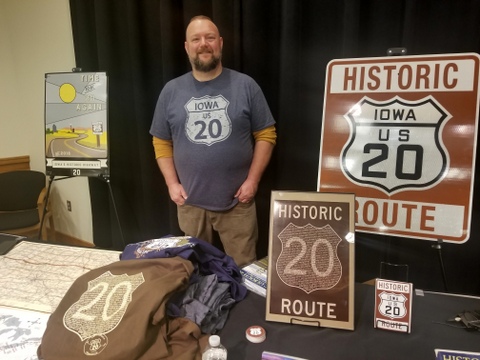
Bryan Farr is the founder and president of non-profit Historic US Route 20 Association, which promotes travel along the original 1926 alignment of US Route 20.
History happened here
The remarkable history of Highway 20 started with the passing of the Federal Highway Act of 1921, which appropriated $75 million for road construction throughout the country. The roads that would become Highway 20 were officially designated during the summer of 1925, with the original alignment of the highway taking shape in 1926.
Creating the modern, efficient, paved, four-lane highway travelers enjoy across Iowa today, however, took decades to create, Farr said. The road was often re-aligned throughout its history, and much of it was gravel for part of the highway’s history. “There are still little sections of the 1926 alignment of Highway 20 outside of Early and Fort Dodge that still are gravel,” Farr noted.
Speaking of Fort Dodge, this Highway 20 city has an unforgettable connection to Cardiff, New York, another Highway 20 town where one of the greatest hoaxes of the nineteenth century took place.
It all started when Stubb Newell of Cardiff, New York, needed a new well. On Oct. 16, 1869, Newell directed two well diggers to a spot he selected behind his barn. The men dug 3 feet and hit something solid. They uncovered a huge stone foot. As they dug more, an entire body of a man emerged. Two days later, a large tent was placed over the 10-foot stone man and crowds of nearly 200 to 500 people a day paid 50 cents to see this giant. Scientists, philosophers and the clergy attended and were challenged in their beliefs, noted the Historic US Route 20 Association website.
Legendary showman P.T. Barnum offered $60,000 for the giant but was turned down. Soon, however, the hoax came to light when people recalled a man named George Hull (a cousin of Newell) had visited a gypsum mine at Fort Dodge in 1868. He commissioned a 5-ton block to be used to carve a statue of Abraham Lincoln. The block of gypsum was shipped to Chicago and carved into this giant man. The carving’s surface was treated with acids and picked at with needles to give it an antiquated look. It was then shipped and buried in New York.
Today, the giant rests at the Farmers’ Museum in Cooperstown, New York. In 1969, a replica was created from the same gypsum quarry and is on display at the Fort Museum in Fort Dodge.
These types of stories offer a unique perspective of Highway 20, which Farr has traveled from coast to coast. “I want to bring people back into small town America, to shop locally and support local businesses to boost economic development in communities that may be bypassed by interstate highways or other more popular routes.”
Gaining a new perspective of Highway 20
Highway 20 is also distinguished by a number of other noteworthy distinctions, including:
• Ties to some of America’s major and mid-sized cities. Highway 20 includes Boston, Buffalo, Cleveland, Chicago and Boise.
• A connection to five presidents. “Highway 20 is a presidential route,” said Farr, citing George Washington as well as Abraham Lincoln, whose famous debates with political rival Stephen Douglas took place in Freeport, Illinois. Highway 20 is also connected Galena, Illinois, where President Ulysses S. Grant had a home. In northern Ohio, Highway 20 passes through Freemont, home of President Rutherford B. Hayes, who served from 1877 to 1881, oversaw the end of Reconstruction and attempted to reconcile the divisions left from the Civil War. Cleveland, Ohio, honors President James Garfield, who was elected president in 1881 but whose service was cut short after 200 days in office when he was assassinated and later died on September 19, 1881.
• The women’s movement organized along the future Highway 20. The Seneca Falls Convention was the first women’s rights convention in the United States. Held in July 1848 in Seneca Falls, New York, the meeting launched the women’s suffrage movement, which more than seven decades later ensured women the right to vote.
• Highway 20 name is more than just name. In 1925, a system of numbered highways debuted in America to replace the jumbled, confusing mess of named auto trails. “Routes with a zero at the end, like Route 20, were transcontinental routes,” said Farr, author of the book “Historic Route 20: A Journey Across America’s Longest Highway.” “Also, east-west routes have even numbers, while north-south routes have odd numbers.”
• Iowa attractions abound along Highway 20. Spanning roughly 330 miles across Iowa from Dubuque to Sioux City, Highway 20 offers plenty to see and do, Farr said. A few options include Dyersville, home of the famous Field of Dreams movie site, the National Farm Toy Museum and the Basilica of St. Francis Xavier; Independence, home of the Heartland Acres Agribition Center, which connects visitors to the past, present and future of Iowa agriculture; Sac County, with its famous barn quilt trail and world’s largest popcorn ball in Sac City and Sioux City, with its rich history related to the journey of the Lewis and Clark expedition nearly 250 years ago.
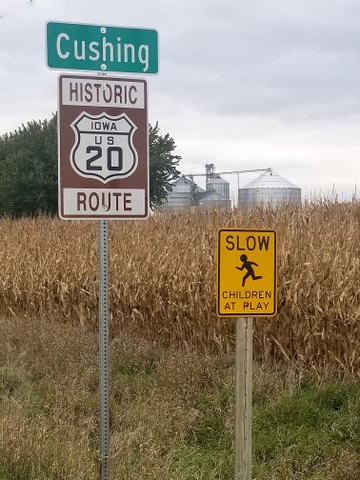
While the first Historic Route 20 sign was placed in Painesville, Ohio, in 2014, Cushing became the first Iowa community to display one of the distinctive signs. This sign greets visitors as they enter the small Woodbury County town from the east on the old route of Highway 20.
It’s interesting to note that bypasses started being built along Highway 20 almost from the start, starting in Massachusetts in the late 1920s. By the 1950s, bypasses in Iowa rerouted Highway 20 out of Farley in eastern Iowa. The trend hasn’t stopped since then. In recent years, communities along historic Highway 20 have been installing signs to denote their unique place along the route. While the first Historic Route 20 sign was placed in Painesville, Ohio, in 2014, Cushing became the first Iowa community to display one of the distinctive signs. This sign greets visitors as they enter the small Woodbury County town from the east on the old route of Highway 20.
While efficient transportation has its place, Farr encourages travelers venture off the interstates and four-lane Highway 20, explore the nearby towns and rural areas and see some the best of America. “Highway 20 is like a companion,” said Farr, who is promoting the new slogan “It’s time to be 20 again.” “This road will take you home.”
Want more?
Thanks for stopping by. I invite you to read more of my blog posts if you value intriguing Iowa stories and history, along with Iowa food, agriculture updates, recipes and tips to make you a better communicator.
If you like what you see and want to be notified when I post new stories, be sure to click on the “subscribe to blog updates/newsletter” button at the top of this page, or click here. Feel free to share this with friends and colleagues who might be interested, too.
Also, if you or someone you know could use my writing services (I’m not only Iowa’s storyteller, but a professionally-trained journalist with 20 years of experience), let’s talk. I work with businesses and organizations within Iowa and across the country to unleash the power of great storytelling to define their brand and connect with their audience through clear, compelling blog posts, articles, news releases, feature stories, newsletter articles, social media, video scripts, and photography. Learn more at www.darcymaulsby.com, or e-mail me at yettergirl@yahoo.com.
If you’re hungry for more stories of Iowa history, check out my top-selling “Culinary History of Iowa: Sweet Corn, Pork Tenderloins, Maid-Rites and More” book from The History Press. Also take a look at my latest book, “Dallas County,” and my Calhoun County” book from Arcadia Publishing. Both are filled with vintage photos and compelling stories that showcase he history of small-town and rural Iowa. Order your signed copies today! Iowa postcards are available in my online store, too.
Let’s stay in touch. I’m at darcy@darcymaulsby.com, and yettergirl@yahoo.com.
Talk to you soon!
Darcy
@Copyright 2018 Darcy Maulsby & Co. Blog posts may only be reprinted with permission from Darcy Maulsby.
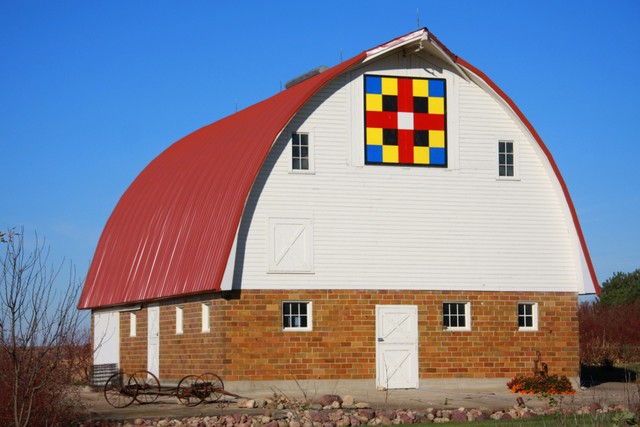
Sac County Barn Quilt Attracts National Attention
When Alvin (Al) Liske and his wife, Jean, signed up for the Barn Quilts of Sac County project, they had no idea how much attention this would attract to their stately World War II-era barn west of Early, Iowa.
“Our barn has been featured in Eleanor Burns’ book, ‘Quilt Blocks on American Barns,’ and it was also included on the cover of the Department of Transportation’s 2009 map of Iowa,” said Jean.
Burns, a popular television personality who gained famed for her “Quilt in a Day” system, visited the Liske barn last year when she traveled to Iowa to participate in the Sac County Quilt-a-Fair. She was especially intrigued by the Country Lanes barn quilt pattern that graces the barn’s haymow door. She noted that Country Lanes is a very old pattern that was originally published by Mountain Mist, a company that began selling quilt batting in Cincinnati in 1846.
“We chose the Country Lanes block, because we live on a gravel road,” said Jean, who works in the registrar’s office at Buena Vista University in Storm Lake. “Even though we’re off the beaten path, it’s not uncommon to see people drive out here and take photos of the barn.”
Jean’s father, Herman Puetz, built the barn for approximately $4,000 around 1943 or 1944 on the Boyer Valley Township farm that his family had purchased in 1930. The new barn replaced an existing barn that was made from cottonwood lumber. After the concrete foundation for the new barn was poured, lumber was not readily available for the building, due to the war. In the meantime, the family roller skated on the concrete slab. “When construction started again, I can also remember going with my parents to Albert Lea, Minn., to get the rafters for the barn, and I thought that was a really long trip,” said Jean, who noted that the barn includes glazed tile on the bottom and originally had wood shingles on the rounded, gothic roof.
Herman kept horses in the barn, said Jean, who added that farming with horses could be dangerous. “One time when my Uncle George was hauling manure on our farm, something spooked the horses, and they ran toward a barbed wire fence. My uncle jumped off, and he broke his ankle, which got infected.”
Jean’s father, who was one of 12 children, also milked cows on the east side of the barn and kept plenty of hay in the haymow. “I’d play in the barn with my brothers and sister, and we’d make tunnels and caves and houses with the bales. When enough hay had been fed, there would be bare spots in the haymow, and we’d play basketball up there,” said Jean, who noted that the haymow still includes basketball hoops.
After Jean married Al and the couple moved to the farm where Jean grew up, the Liskes raised cattle and hogs in the barn and farmed from the early 1960s until the 1980s. In 2005, the couple decided to remodel the barn, which still had a good foundation. “It was getting to the point where we needed to fix up the barn or think about tearing it down, and we didn’t want to watch the barn fall down,” said Jean, who noted that the family power washed the interior, rebuilt windows and doors, had the barn rewired, covered the roof with red steel and added a staircase to the haymow.
The barn, which is now used for storage, became
a favorite play area for the Liske’s grandchildren. “The barn is an important part of our family’s heritage, and it’s one of the few old buildings left on this farm,” Jean said. “My dad was always proud of the barn, and we’re glad we’ve maintained it.”
Note from Darcy: I first wrote this piece in 2010 for Farm News.
Want more?
Thanks for stopping by. I invite you to read more of my blog posts if you value intriguing Iowa stories and history, along with Iowa food, agriculture updates, recipes and tips to make you a better communicator.
If you like what you see and want to be notified when I post new stories, be sure to click on the “subscribe to blog updates/newsletter” button at the top of this page, or click here. Feel free to share this with friends and colleagues who might be interested, too.
Also, if you or someone you know could use my writing services (I’m not only Iowa’s storyteller, but a professionally-trained journalist with 20 years of experience), let’s talk. I work with businesses and organizations within Iowa and across the country to unleash the power of great storytelling to define their brand and connect with their audience through clear, compelling blog posts, articles, news releases, feature stories, newsletter articles, social media, video scripts, and photography. Learn more at www.darcymaulsby.com, or e-mail me at yettergirl@yahoo.com.
If you’re hungry for more stories of Iowa history, check out my top-selling “Culinary History of Iowa: Sweet Corn, Pork Tenderloins, Maid-Rites and More” book from The History Press. Also take a look at my latest book, “Dallas County,” and my Calhoun County” book from Arcadia Publishing. Both are filled with vintage photos and compelling stories that showcase he history of small-town and rural Iowa. Order your signed copies today! Iowa postcards are available in my online store, too.
Let’s stay in touch. I’m at darcy@darcymaulsby.com, and yettergirl@yahoo.com.
Talk to you soon!
Darcy
@Copyright 2018 Darcy Maulsby & Co. Blog posts may only be reprinted with permission from Darcy Maulsby.
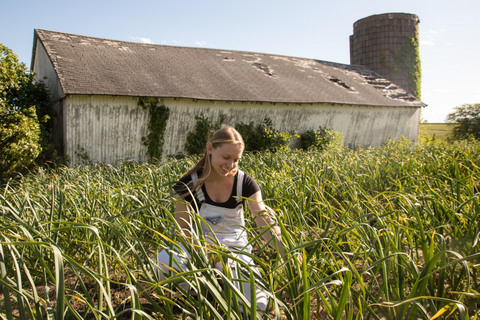
Ultra-Local Eating: Jennifer Miller Guides CSA, Iowa Food Cooperative
Jennifer Miller could hardly believe the question. “When will your bananas be ready?” inquired a central Iowa woman who was buying fresh produce through Miller’s Clarion Sage market garden and community supported agriculture (CSA) business near Waukee.
“People are disconnected from where their food comes from,” said Miller, 30, who noted the woman seeking locally-grown bananas is a well-educated business professional. “I’ve even had people look at our heirloom tomatoes and say, ‘I don’t want those,’ because they think they are GMOs.’”
This disconnect isn’t all that foreign to Miller, who grew up in Highland Park, Illinois, a northern suburb of Chicago. “I had no contact with agriculture in Highland Park,” said Miller, who serves as the Iowa Food Cooperative’s member services coordinator.
Miller did have a connection with Iowa, though, through her paternal grandparents, who lived in the Clarion/Rowan area. Her decision to move to Iowa in 2010 was spurred, in part, by a health challenge and new-found passion for healthy eating.
Miller was diagnosed a number of years ago with celiac disease, a serious autoimmune disorder where consuming gluten can damage the small intestine. “I started caring more about cooking and healthy recipes, because I just wanted to feel better,” said Miller, whose gluten-free and vegan recipes on her blog caught the attention of Martha Stewart Living editors, who invited her to develop recipes for them. “That’s what got me into food and agriculture.”
Food can be so much more interesting
After moving to Iowa, Miller got involved with community gardens in the Des Moines area and became a marketing/communications specialist Iowa Food Cooperative, which operates like an online farmers market. In 2013, Miller and her partner, Cody Kilgore, moved to an acreage on the southwest edge of Waukee’s city limits in Van Meter Township so they could operate their own farm.
“It felt like coming full circle,” said Kilgore, who was raised in rural Missouri, worked in the corporate world for nearly 30 years and was ready for a career switch.
 The couple planted garlic in the fall of 2013 to start their Clarion Sage market garden. The goal? “We believe in ultra-local and want to feed the community around us,” said Miller, who noted that Clarion Sage primarily serves families within a five-mile radius in southern Dallas County.
The couple planted garlic in the fall of 2013 to start their Clarion Sage market garden. The goal? “We believe in ultra-local and want to feed the community around us,” said Miller, who noted that Clarion Sage primarily serves families within a five-mile radius in southern Dallas County.
Today, Miller and Kilgore raise a wide array of vegetables and herbs, including lettuce, squash, cabbage, carrots, garlic, tomatoes, cucumbers, peppers, potatoes and more, including heirloom varieties that can’t be found in most stores. They offer an online ordering system for added convenience.
“Food can be so much more interesting,” Miller said. “Whether you’re sharing a family meal, providing snacks for your kids or making a favorite recipe, one thing’s for sure: the starting point for all these is good food.”
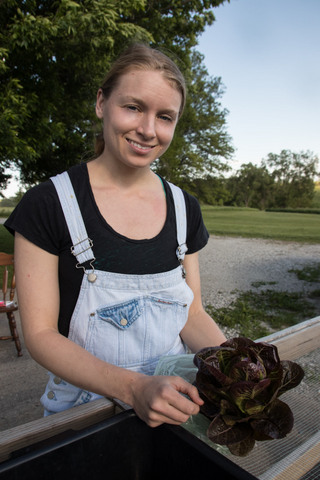
Jennifer Miller displays one of the unique lettuce varieties she grows at Clarion Sage Farm near Waukee.
Six lessons learned about farming and food
As their business evolved, Miller and Kilgore have adjusted their marketing plan to adapt to the often surprising—and sometimes frustrating—buying patterns they’ve observed in the market. The Clarion Sage market garden and CSA have taught them six key lessons, including:
1. Farming is more than production. Raising an abundant crop is just step one, said Miller, who has learned that that marketing and sales are equally important.
2. Mentors matter. “I didn’t grow up gardening, so working for various produce growers in Iowa and beyond taught me so much,” said Miller, who is grateful for leaders like Angela Tedesco who started Turtle Farm near Granger, Jill Beebout from Blue Gate Farm near Chariton and other local food proponents who have mentored her along the way.
3. Buying local adds flavor to life. Clarion Sage’s customers appreciate the “know your farmer” philosophy. Most buyers tend to be in their 30s and 40s with families, or they’re retired and have an interest in good food and time to cook. “Every week we offer our customers about $30 worth of fresh vegetables,” Miller said. “We focus on staple items like lettuce, potatoes, carrots and tomatoes, with the opportunity for more exotic options like stir-fry greens, kale and eggplant.”
4. Catering to consumers can be tricky. While the Clarion Sage CSA is right on Waukee’s doorstep, some consumers don’t want to drive to the farm to pick up vegetables. Some feel they don’t have time, while others don’t like the way the gravel road makes their vehicle dusty. When Miller tried offering delivery, some consumers still rejected this option, citing a lack of time or interest in preparing fresh food. Even full-color newsletters filled with cooking tips and recipes failed to gain much traction with these types of consumers, said Miller, who plans to start selling her produce at the Downtown Farmers’ Market in Des Moines.
5. Urban sprawl is relentless. High-density residential projects are planned for the area near the Clarion Sage’s market garden. “We’re in the bullseye of urban sprawl, which is a challenge,” said Kilgore, who also works as a wedding photographer.
6. Local food pairs well with global flavors. Miller loves ethnic cooking, from Latin American to African. “If you want to add more vegetables to your diet, look to other cultures that don’t have an abundance of meat protein,” said Miller, who encourages people to try vegetables like Cherokee Purple heirloom tomatoes (known for their smoky, complex flavor), fish peppers (which pack more heat), Merlot lettuce (whose dark red leaves offer a mellow flavor) and fingerling potatoes (which taste great fried or roasted).
Food is one of the best parts of life, added Miller, who loves the creativity involved in growing and marketing a crop. “You see a crop through from beginning to end, and you’re producing something that can feed and sustain people. That’s amazing to me.”
Want more?
Thanks for stopping by. I invite you to read more of my blog posts if you want more more intriguing Iowa stories and history, along with Iowa food, recipes and tips to make you a better communicator. If you like what you see and want to be notified when I post new stories, be sure to click on the “subscribe to blog updates/newsletter” button at the top of this page. Feel free to share this information with friends and colleagues who might be interested, too.
If you’re hungry for more stories of Iowa history, check out my top-selling “Culinary History of Iowa: Sweet Corn, Pork Tenderloins, Maid-Rites and More” book from The History Press, as well as my Calhoun County” book from Arcadia Publishing, which showcases the history of small-town and rural Iowa. Order your signed copies today! Iowa postcards are available in my online store, too.
Let’s stay in touch. I’m at darcy@darcymaulsby.com, and yettergirl@yahoo.com.
P.S. Thanks for joining me. I’m glad you’re here.
@Copyright 2017 Darcy Maulsby & Co.
About me:
Some people know me as Darcy Dougherty Maulsby, while others call me Yettergirl. I grew up on a Century Farm between Lake City and Yetter and am proud to call Calhoun County, Iowa, home. I’m an author, writer, marketer, business owner and entrepreneur who specializes in agriculture. Learn more at www.darcymaulsby.com.

Behind the Scene at Iowa’s Own Market to Market
If you’ve lived in Iowa, especially on a farm, anytime from the mid-1970s to today, there’s a good chance your family has tuned into Iowa Public Television (IPT) on Friday nights (or possibly Sunday afternoons) to watch Market to Market. That’s how it has been at my family’s Century Farm, and it’s a tradition that makes me proud to be an Iowan.
After all, Iowa is the home of Market to Market, which has covered issues affecting agriculture, from global trade conflicts to environmental controversies to changing technology, for more than four decades. Today, the weekly news segments and market commentary are geared towards the nearly 60 million people who live and work in rural America.
 Even when I was too young to really know what Market to Market was all about, I could always identify the show by its music. I didn’t know the ending theme song was “Buy for Me the Rain” by the Nitty Gritty Dirt Band. I just called it the Market to Market song, and I’m glad it’s still part of the show.
Even when I was too young to really know what Market to Market was all about, I could always identify the show by its music. I didn’t know the ending theme song was “Buy for Me the Rain” by the Nitty Gritty Dirt Band. I just called it the Market to Market song, and I’m glad it’s still part of the show.
History and tradition are part of Market to Market, the longest-running TV show of its kind. The first episode of Market to Market debuted on October 24, 1975, on IPT. Back then, the show was called “Farm Digest,” I learned from Dave Miller, a senior producer/director who has worked at IPT more than 33 years.
I met Miller in July when my family and I toured the IPT studio in Johnston. The tour came about after Josh Buettner, an IPT producer/director, visited our farm a few years ago to shoot a segment on water quality. He mentioned that if I’d ever like to watch a taping of Market to Market, he could arrange it.
I thought it would be cool to take him up on this unique opportunity, since my family has been Market to Market fans for decades. When we pulled up outside the gleaming white studio on a hot Friday afternoon in July, we felt like royalty as IPT staff members greeted us at the front door and welcomed us into the bright lobby. When we were ushered back to the control room around 4 p.m., I was amazed by how dark the rest of the building is.
As we took our seats around the edge of the room, it wasn’t long before a staff member called out “We’re 15 seconds away. Stand by everybody, stand by!”
At the word “go,” vibrant images flashed onto row after row of computer monitors that glowed against the black surroundings. “Thunder!” called out one producer as the famous Market to Market logo shot onto the screens.
About 10 minutes later, we were ushered across the hall into the cavernous main studio, where Market to Market host Mike Pearson sat at a spacious desk and prepared to interview analyst Tomm Pfitzenmaier. As the red digital numbers counted down on a monitor near us, it seemed surreal to watch the interview in progress, both in person just a few feet from us and on a TV monitor right in front of us.
 As I took it all in, from the thick power cords snaking across the floor to the huge cameras to lights of all types hanging from the black ceilings, I wondered what the technology was like back when Chet Randolph hosted the show. Dave Miller filled in some of the gaps. “I can remember when we had to run the tapes to the bus station in Des Moines so they could be put on an express bus to Lincoln, Nebraska, which had the nearest uplink,” he noted.
As I took it all in, from the thick power cords snaking across the floor to the huge cameras to lights of all types hanging from the black ceilings, I wondered what the technology was like back when Chet Randolph hosted the show. Dave Miller filled in some of the gaps. “I can remember when we had to run the tapes to the bus station in Des Moines so they could be put on an express bus to Lincoln, Nebraska, which had the nearest uplink,” he noted.
Wow, times have definitely changed. Still, one thing hasn’t changed—the Market to Market team’s commitment to share timely news and ag-related feature stories each week. When the show wrapped up and I heard the familiar notes of “Buy for Me the Rain,” it was amazing to think that the segments recorded right in front of our eyes would be broadcast to 20 states from California to Tennessee in just a few hours—and it all starts right here in Iowa.
This piece originally appeared on Farm News.
Want more?
Thanks for stopping by. I invite you to read more of my blog posts if you want more more intriguing Iowa stories and history, along with Iowa food, recipes and tips to make you a better communicator. If you like what you see and want to be notified when I post new stories, be sure to click on the “subscribe to blog updates/newsletter” button at the top of this page. Feel free to share this information with friends and colleagues who might be interested, too.
If you’re hungry for more stories of Iowa history, check out my top-selling “Culinary History of Iowa: Sweet Corn, Pork Tenderloins, Maid-Rites and More” book from The History Press, as well as my Calhoun County” book from Arcadia Publishing, which showcases the history of small-town and rural Iowa. Order your signed copies today! Iowa postcards are available in my online store, too.
Let’s stay in touch. I’m at darcy@darcymaulsby.com, and yettergirl@yahoo.com.
P.S. Thanks for joining me. I’m glad you’re here.
@Copyright 2017 Darcy Maulsby & Co.
About me:
Some people know me as Darcy Dougherty Maulsby, while others call me Yettergirl. I grew up on a Century Farm between Lake City and Yetter and am proud to call Calhoun County, Iowa, home. I’m an author, writer, marketer, business owner and entrepreneur who specializes in agriculture. Learn more at www.darcymaulsby.com.
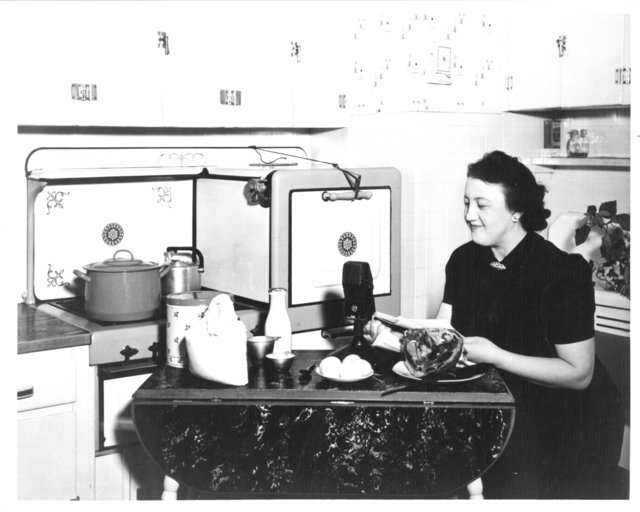
Cooking with Iowa’s Radio Homemakers
Long before there was Martha Stewart, there were KMA’s radio homemakers. These creative, talented ladies from southwest Iowa revolutionized women’s roles far beyond their humble farm kitchens starting in the 1920s. As they delighted Midwestern audiences by sharing their favorite recipes and providing down-home, daily visits with their radio friends, some of the women also became successful entrepreneurs along the way.
Their story begins in the early 1920s with the debut of a fabulous new invention called radio. In 1925, when a local businessman named Earl May began broadcasting KMA Radio-960 from Shenandoah, Iowa, to promote his seed and garden business. The station gained a following by airing practical information designed to help with the day-to-day life in Midwestern farm kitchens.
Before long, KMA was a trusted friend throughout the wide listening area, offering inspiration, companionship, and all manners of domestic counsel. The power of this connection can’t be understated when you consider the era—a time when farm wives were much more isolated than today due to poor roads, limited social opportunities and long days filled with endless chores.
A roster of personable, lively women who quickly became known as the KMA Radio Homemakers hosted KMA’s daily radio programs, including the Home Hour, the Stitch and Chat Club, and the KMA Party Line, while live cooking demonstrations drew thousands to the KMA auditorium in Shenandoah.
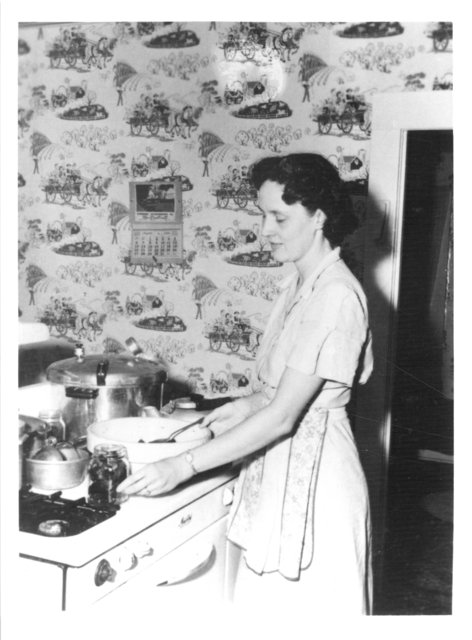
Evelyn Birkby was one of the beloved radio homemakers from southwest Iowa.
Broadcasts reached across the Midwest
The radio homemakers’ history is also linked to Earl May’s local competitor, Henry Field, another nursery and garden entrepreneur who seized on the power of radio to help expand his business. Field recruited family members to go on the air, including his sister, Leanna Field Driftmier, who began broadcasting “The Mother’s Hour,” which became “Kitchen Klatter.” Without any training, Leanna sat down at the microphone and just started talking about her home, family, recipes, household tips, advice for child- rearing and whatever news seemed worth sharing during the afternoon show.
In 1930, Leanna broke her back in a car accident but wanted to continue her show, despite her injuries. The radio equipment was brought to her home, and she broadcast from her bed and later from her kitchen table. The show became so popular amongst listeners that it was eventually was broadcast in six Midwestern states.
Neighboring on the air
As the radio homemakers’ concept gained momentum, local farm women like Evelyn Birkby began broadcasting from their kitchens in the 1950s. In her show “Down a Country Lane” on KMA Radio, Birkby would discuss her family and share snippets from her daily life, as well as offer suggestions for making the home a more pleasant place to live. Birkby called this phenomenon “neighboring on the air,” and it met a vital need when farm life could often be isolating.
Fans would follow the doings of favorite homemakers for years, tuning in each day the same way they’d listen to episodes of radio soap operas. Of course, recipes figured prominently in the broadcasts, with old-fashioned, Midwestern fare focused on meat and potatoes, hearty casseroles, cakes, pies, cookies and more.
Kitchen Klatter became home-grown success
Through the years, a line of Kitchen Klatter products (including food flavorings, bleach and more) was developed and sold over the radio by broadcasters like Leanna Driftmier. In addition, a monthly Kitchen Klatter magazine was circulated to thousands of Midwestern readers who enjoyed the articles, letters and recipes like Company Ham and Potatoes, Emerald Mint Sauce (made from Kitchen Klatter Mint Flavoring), Mary’s Pineapple Pie and Grandma’s Oatmeal Cookies. The Kitchen Klatter enterprise and the radio homemakers endured for a number of years, with some of the broadcasts lasting until the 1990s.
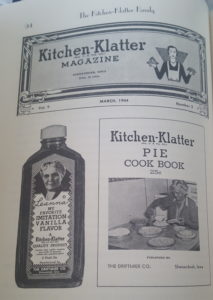 Recipes preserve a taste of Iowa history
Recipes preserve a taste of Iowa history
In 1991, Evelyn Birkby published the fascinating book “Neighboring on the Air,” where you can almost hear the voices of the KMA homemakers while you get a taste of their philosophy of life and sample their recipes. You can learn how to make hearty Midwestern fare ranging from Sour Cream Apple Pie from Florence Falk, “The Farmer’s Wife,” to Six-Layer Washday Dinner from Doris Murphy, who took to the air in 1949 with her “Party Line” broadcast.
You’ll get a sense what a grueling schedule the radio homemakers often endured as they broadcast radio shows out of their kitchen while their own family life went on about them. These ladies also knew the needs and interests of their audience, because they, too, were well acquainted with hard work, hard times and making do.
Through it all, the radio homemakers were Martha Stewart and Dear Abby all rolled into one as they shared news about their children, home beautification tips and their trusted recipes. Thousands of devoted listeners depended on them for weekly entertainment, information, humor and continuity. These listeners considered the radio homemakers a valued part of their lives, which is reflected in the longevity of the radio shows. The radio homemakers’ remarkable contributions are an enduring legacy to power of Iowa farm women and add unforgettable flavor to Iowa’s rich culinary heritage.
Six-Layer Washday Dinner
Like today’s busy working women, Iowa’s radio homemakers like Doris Murphy knew the value of being able to put a hearty, nutritious meal on the table without a lot of fuss. No doubt her recipe featured home-grown and home-canned vegetables.
2 cups hamburger
1 small onion, chopped
2 cups diced potatoes, raw
½ cup uncooked rice
1 cup sweet peppers, cut fine
1 cup diced carrots, raw
1 pint tomatoes
Brown hamburger and onion together. Combine meat, onion, potatoes, rice, peppers, carrots and tomatoes. Season with salt and pepper. Cover with water. Cook 2 hours in 350-degree oven.
Want more Iowa culture and history?
Read more of my blog posts if you want more Iowa stories, history and recipes, as well as tips to make you a better communicator.
If you’re hungry for more stories of Iowa history, check out my top-selling “Culinary History of Iowa: Sweet Corn, Pork Tenderloins, Maid-Rites and More” book from The History Press, as well as my Calhoun County” book from Arcadia Publishing, which showcases the history of small-town and rural Iowa. Order your signed copies today! Iowa postcards are available in my online store, too.
P.S. Thanks for joining me. I’m glad you’re here.
@Copyright 2017 Darcy Maulsby & Co.


